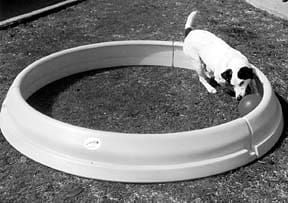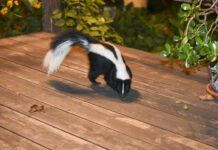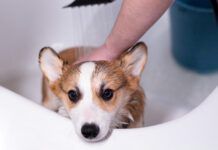Testing new toys! This is always our favorite assignment, since we get to spend lots of time playing with our dogs. We have once again perused the pages of various dog supply stores, catalogs, web sites, and trade shows to find a selection of new toys to review. This time, we found a greater than usual percentage of delightful surprises, though we were, as usual, also disappointed a few times.
All in all, remember that proper toy selection is a very individualized venture – you must keep your own dog’s interests, propensities, and chew power in mind when shopping for her.
The reviews here are based on the following criteria:
Dog appeal and human appeal
Obviously, a toy should be attractive in texture and overall appearance; just as obviously, appeal can vary widely from dog to dog and person to person. One dog’s absolute favorite toy might be the next dog’s “Booooring!” But the whole purpose of a toy is to entertain a dog – and, to a slightly lesser extent, the people who enjoy him. Ask any trainer and she will tell you: A bored dog is often a destructive, “misbehaving” dog. Playing with toys can keep a lonely dog busy, give an undermotivated dog incentive to interact with you, and give you endless opportunities to enjoy each other. So, the toy has to look and feel . . . fun!
Safety
Toys should pose no casual danger to the dog. Any toy can be chewed up by some dogs, even the incredibly durable black Kong toy. The toy assortment that is suitable for aggressive chewers is much more limited than the variety of toys for dogs who don’t tend to chew up their toys. But no toy should begin to come apart after just a minute or two of play, exposing dangerously small or toxic components, such as stuffing or threads that can cause internal problems if swallowed.
Even though we deplore the lack of garden variety common sense that necessitates warning labels on dog toys, we like to see safety warnings included with every toy. Most people need to be reminded to supervise their dogs with every toy, and to buy appropriately sized toys for their dogs (no dog should have a ball that he could accidently swallow, for example). If a toy poses special risks – say, a toy that includes rope that contains long threads – then the label ought to include warnings specific to that toy. (For instance. “Do not allow your dog to chew up or swallow the rope or rope fibers as these can cause damage to the gastrointestinal tract.”)
Durability
While the perfect chew object for Tiffany may be shredded in an instant by Jaws, you want the toy to provide at least a few weeks or months of entertainment. At least, we do! We really don’t fancy spending an appreciable percentage of our monthly budget on toys that last only hours or days.
Cost
The above statement notwithstanding, we’re willing to pay more for something that provides tons o’ fun and lasts forever. If it doesn’t meet these criteria, it had better be cheap!
Top new toys
We had better discuss the PitBall while we are talking about spending small fortunes. Yes, this is a fabulously expensive toy; at $129, it’s not a casual purchase for most dog owners. But the PitBall is a be-all, end-all toy for ball-obsessed dogs; it’s not your average dog toy. Think of it as playground equipment rather than a toy, and the price sounds better. For the right dog – one who loves to chase balls and constantly has excess energy (read Border Collie or Jack Russell Terrier), the PitBall can be a godsend.
Created by Gary Bessette, owner and operator of the Puppy PlayGround in Ormond, Florida (see “Members Only clubs For Dogs,” below.), this toy consists of a molded plastic ring, five feet in diameter, and a hard plastic ball, too large and too hard for a dog to pick up in his mouth. The ring is shipped in three pieces, which snap together easily and can be staked to the ground. The concept is simple – the dog chases the ball around and around and around the ring until he gets bored, tired, or until the owner puts the ball away.
Several of our test dogs had no interest in the PitBall – chasing a plastic ball around in an endless circle just wasn’t their thing, and they couldn’t be bothered. Our Scottish Terrier tester showed moderate interest and played with the ball for a few minutes. We left it out for him to play with, and about once a day he will take a turn in the pit, romping with the ball for about five minutes before he gets bored with it. (He did manage to push the ball over the top of the ring once, and thought it was much more exciting to chase the ball around the entire fenced back yard – until it got stuck in a low corner.)
Our Jack Russell tester was another story. He quickly became addicted to the toy; he couldn’t get enough of it. He harassed the red ball mercilessly until we put it away, fearing that the little guy would overexert himself. Every time we brought the ball back out, he ran to the “pit,” ready for play. PitBall proved to be a perfect outlet for his over-the-top JRT energy. There was only one problem: he, too, became adept at flipping the ball out of the ring, and he was just as happy to chase it around the yard. We’ll need a much heavier ball to keep him in the pit.
If your dog loves to chase balls and leans toward obsessive behaviors and hyperactivity, this might be your ticket to a happy, tired pet and a calmer household. Just don’t let him overdo it – be sure to restrict his PitBall activity to a healthy level – physically and mentally.
Stuck on a stick
Boy, were we skeptical about paying $15 for a stick to throw for our dogs, especially since we figured that our moderately hard chewers would turn it into toothpicks in no time. We were delightfully surprised; we have been using the stick for more than two months now, and whatever “non-threatened hardwood” it is made of is pretty darn tough – our dogs’ teeth have barely made a mark on it. We love the Fetch!
Fetch is a 12-inch piece of hardwood, rounded on the ends and tapered in the middle, and, according to the amusing booklet that comes with it, is individually hand-tooled, rubbed to super smoothness, and safe, durable, and non-toxic. It’s almost more a work of art than a dog toy! The maker of the Fetch says it should last forever. We believe it. Our dogs certainly hope so. Of course, we don’t leave it out for them to chew on when we’re not playing fetch, but still, we expected more damage than this.
Our only caveat is that it’s heavy and solid enough that you need to be careful with your aim; you wouldn’t want to bonk your dog on the head, and you wouldn’t want him to try to catch it in his mouth – it might break a tooth!
Getting a handle on it
We wouldn’t want the job of inventing a new type of ball, but the maker of the Action Ball has certainly gotten creative with the task. The Action Ball is essentially a regular ball – it comes in a football, soccer ball, or basketball model – with tough nylon straps harnessed around the ball with two rope tugs extending at opposite ends (look at the photo, above center; it’s hard to describe!).
Our dogs thoroughly enjoyed playing with the ball: chasing it (it’s too big to bite) and carrying it around by the ropes. They play with it by themselves, with each other, and with us. Our 75-pound Cattle Dog mix, Tucker, will grab one rope and drag 20-pound Dubhy around, firmly attached to the other. After more than two months of hard play, our soccer ball is slightly deflated, but still round and very usable (the ball can be easily reinflated with a bike pump and special needle for this purpose). The nylon straps are still intact, and the rope tugs, while somewhat shredded, are still serviceably tuggable.
The Action Ball is one of our dogs’ all-time favorite toys (and ours!). It meets our criteria for a safe tug-of-war toy – long enough that dog teeth stay far away from human flesh, and the ball neatly prevents the dog’s grip from creeping higher and higher up the rope – a hazard with some tug toys.
Improving the tennis ball idea
We were happily surprised by the durability of this simple toy – a hard, hollow, rubber ball, about four inches in diameter and covered with a tough patterned plush.
We’ve never been able to confirm rumors that ordinary tennis balls contain harmful adhesives (or something), but we’re happy to see the manufacturers claim on the ZooBeez balls that the products do not contain toxins of any kind. Dogs who are more determined than ours to dismantle a ZooBeez ball might succeed in doing so, but our ball has held up quite well in the jaws of some pretty tough testers, with no visible signs of damage after two months of dog exposure. While this toy lacks some of the novelty and excitement of our top choices, it is an attractive, sturdy, usable, and affordable item worth adding to your dog’s toy box.
(Not so) tough
These soft toys are so cute, and since they are advertised as “tennis ball tough” we had high hopes that we had finally found a sturdy, soft chew toy. Our hopes were quickly dashed. It took our test dogs fewer than three hours to pop the seams of our adorable Tennis Tough horse (it comes in several animal shapes) and pull out the stuffing.
True, the outer cover itself is tough, and our dogs tossed around the empty horse shell for several days after we removed the stuffing and squeaker, before we finally threw it out. At that point the seams had deteriorated even further, so we were finding pieces of blue horse all over the house.
This is a great soft toy for gentle chewers; two of our dogs would have treasured this toy for years if not for their destructive siblings. If the maker could just find a way to make the seams tougher, it might hold up for stronger chewers, too.
Not comfortable
This 16-inch-long product pictured in the catalog looked like it had great potential to be a safe and sturdy tug toy, with interesting shapes for the dog to grip.
Sturdy it is, indeed. We purchased the “Chew Bar and Inner Tube” model, and found that the plastic bar and tube are so hard that our dogs didn’t even like to hold onto them, preferring instead to grab for the soft nylon rope that holds the pieces together. This put our canines’ canines uncomfortably near my hand, which was holding onto the uncomfortable green plastic handle.
(Note: Contrary to some trainers’ philosophies, we like playing tug-o-war with our dogs. For safety rules and training advice, see “Play and Train by Tugging,” March 1999.)
The same product designed with a little more give in the plastic parts might be a winner, but for now, we’ll pass on this one.
No date for Bettie
The Bettie is an attractive three-legged throw toy, eight inches across, made of a non-toxic rubbery material. The packaging promises that the “buoyant material makes water play fun,” that the “chewy hollow legs” can hold tasty treats, that the “lightweight construction makes throwing a breeze,” and the shape makes it “perfect for tug-o-war.”
Well, it does float.
A small note on the back of the pakaging says, “not recommended as a chew toy.” We concur. It took our Scottie tester a total of three minutes to destroy the Bettie. Even a few retrieves with a dog who mouths the retrieve object at all would do terminal damage to the Bettie, and tug-o-war is out of the question. If you have a soft-mouthed retriever who doesn’t bite down at all, the Bettie might do it for you. Otherwise,your dog is far better off with a Fetch stick.
-By Pat Miller





